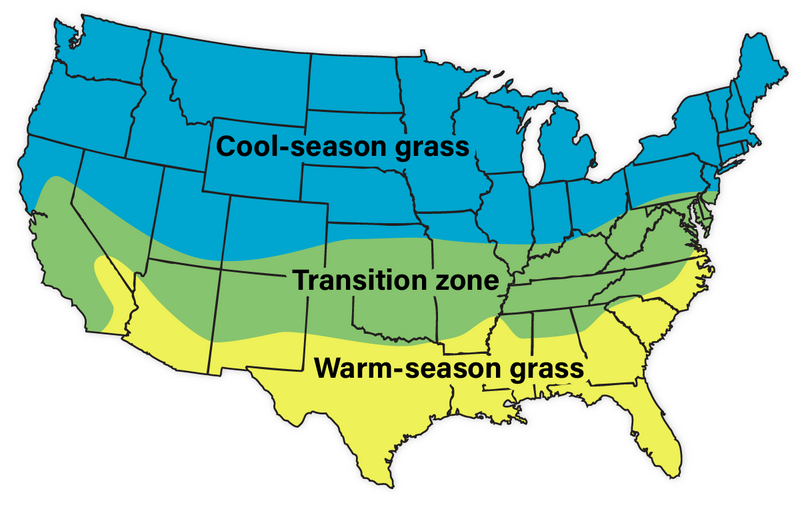
How high you cut your grass is an important consideration for a healthy lawn. In this article, we’ll discuss the ideal mowing height for your grass type so you can create a healthier lawn with every cut.
Ideal Grass Height
How high to cut the grass varies depending on the species of grass. Here are a few recommendations from Cooperative Extension publications across the country.
If you have warm-season grass, check out these mowing heights from the University of Georgia’s College of Agricultural & Environmental Sciences:
| Grass | Type of Grass | Mowing Height |
| Centipede grass* | Warm Season | 1-2 inches |
| Common bermudagrass* | Warm Season | 1-2 inches |
| Hybrid bermuda* | Warm Season | 1-1.5 inches |
| St. Augustine* | Warm Season | 2-3 inches |
| Zoysiagrass* | Warm Season | 1-2 inches |
If you have cool-season grass, consider these mowing recommendations from universities across the country:
| Grass | Type of Grass | Mowing Height |
| Creeping red fescues | Cool Season | 3-3.5 inches |
| Kentucky bluegrass | Cool Season | 2.5-3.5 inches |
| Perennial ryegrass | Cool Season | 1.5-2.5 inches |
| Turf-Type Tall Fescue* | Cool Season | 2-3 inches |
- * Increase mowing height by a half inch inch during the hottest months.
If you’re in the northern part of the country, from Maine down to Pennsylvania and across to California, you probably have a cool-season grass. If you live from West Virginia down to North Carolina over to southern California, you may have either warm- or cool-season grass. (This area is called the Transition Zone.) If you live in the southern parts of the country, from South Carolina down, you likely have warm-season grass.
Check out our handy map to help you determine which area you live in.

A note on grass height
You will notice regional differences in mowing height recommendations. This lawn calendar from the University of Georgia recommends Zoysia be mowed at 1 to 2 inches or up to 2.5 inches during the warmer months. But the University of Kentucky recommends Zoysia be cut from 1 to 3 inches.
If you are unsure about the best grass height for your lawn, you can always ask your local Cooperative Extension service for help.
How much to cut
If your grass has gotten overgrown and you are wondering how much you should cut at one time, we’re glad you asked.
There is an important rule in the landscaping industry called the “one-third rule” of mowing. It simply says: Don’t cut more than one-third of the grass blade per mow.
While it may be convenient to cut off more than one-third of the blade if the grass is overgrown, resist. If you cut too much of the blade at once, the grass can become overly stressed and stop growing the root system so it can focus on the leaves and shoots.
Remember, a strong root system helps fortify the grass against drought and other stresses, so keeping it strong is a top priority.
FAQ
For the last cut in the fall and the first cut in the spring, set the lawn mower a little lower than usual as a general rule of thumb. Although some say to keep the grass at a normal height going into winter, others recommend cutting it lower so fungi such as snow mold don’t have a chance to take hold. Since winter conditions vary across the country, ask your Extension agent for local advice.
Experts recommend reducing the cutting height for your first mow in the spring as well. This helps remove debris and get the lawn off to a good start. As soon as the turf starts to grow again, mow at the proper mowing height.
Not under normal conditions. Use a mulching mower blade and leave the grass clippings on the lawn. This puts valuable nitrogen and other nutrients back into the grass.
As long as you follow the one-third rule, your clippings will not contribute to the thatch on your lawn.
Here are a few mowing tips to make your lawn look great:
✓ Mow when the grass is dry.
Wet grass leaves unsightly clumps on the lawn and smothers the grass.
✓ Vary your mowing patterns each time you cut.
This helps to keep the grass growing straight and prevents mower wear on the lawn.
✓ Err on the tall side.
Cut on the higher side of the ideal height range, if you can. Taller grass helps prevent crabgrass and other annual weeds from germinating. Tall grass blades also help the root system grow deep.
✓ Keep your mower blade sharp.
Dull blades tear; sharp blades slice.
✓ Don’t water after 9 a.m.
This helps prevent fungus from developing.
✓ Water infrequently but deeply.
Aim for 1 inch of water once per week.
A healthy lawn begins with proper mowing
Mowing your grass is the first step to getting a healthy lawn. Mow according to the recommended height for your grass (and region), and don’t mow more than one-third of the blade at a time. Following these tips will help you have healthier grass throughout the year.
Want someone else to take on your mowing chores? Hire a professional to cut your grass at the right height every time.
Main Photo Credit: Katya Austin | Unsplash